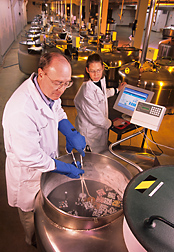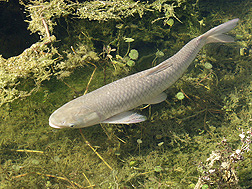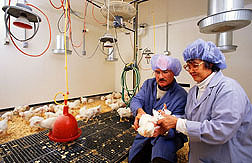Animal Gene Collections Support U.S. Research
|
|
The National Animal Germplasm Program (NAGP) opened in Fort Collins, Colorado, in 2000, with genetic material from 40 chicken lines. Since then, the collection has expanded to include dairy and beef cattle, swine, sheep, goats, bison, elk, and fish. Today, NAGP houses more than 547,000 samples of genetic material, or germplasm, from more than 12,000 animals. This collection—like all Agricultural Research Service collections of animal germplasm—preserves the genetic diversity of agriculturally important animals.
Providing genetic material for genomic studies is one of the most important functions these collections serve. NAGP, for example, has distributed samples from about 2,500 animals to ARS researchers and their university colleagues. ARS scientists have used bull semen acquired from NAGP to genotype prominent bulls that had sired dairy cattle. This information, combined with milk-production data gathered from those cows, has been used to improve dairy cattle breeding programs. Similar work has been done with beef cattle and pigs by ARS researchers in Clay Center, Nebraska.
In many cases, these collections have helped U.S. animal producers save money, but ARS animal collections aren’t simply economical. They provide information for researchers and breeding material for animal producers, and they play an instrumental role in protecting and improving agricultural livestock.
Jurassic Pork: Protecting and Promoting Rare Agricultural Breeds
Animal genetic material can’t raise the dead. But it can be used to revive animal lines that have died out. Researchers at Purdue University arranged to save semen from a unique line of pigs that had two mutations that negatively influenced meat quality. Maintaining live pigs is expensive and time-consuming, so the population was terminated when the studies involving the herd concluded. At the request of Purdue researcher Terry Stewart, NAGP scientists gathered semen from three of the boars in the study and added the samples to their extensive collection of animal genetic materials.
|
|
A few years later, Stewart and his colleagues decided to take the research in a new direction. By that point, the original herd was long gone, but the scientists were able to resurrect the line by inseminating seven sows with the saved semen. All the sows became pregnant and bore litters, indicating that in some instances, cryopreserving genetic material may be a more efficient use of time and money than maintaining a live herd.
“This is the first time a line has been cryopreserved, discontinued, and reestablished using germplasm frozen and stored by NAGP,” says animal geneticist and NAGP coordinator Harvey Blackburn.
The NAGP collection has also been used to prevent existing lines from dying out. For example, scientists at NAGP have collected and distributed germplasm to support a rare breed of dairy cattle.
Shorthorn cattle first came to the United States in the 19th century from the United Kingdom. Imports increased significantly after the breed was successfully crossed with the Texas Longhorn. The exact number of milking and beef Shorthorns in the United States today is unknown, but in 2000, there were about 2,800 milking Shorthorns registered. Though they have lower milk yields than Holstein or Jersey cows, Shorthorns are valued for their calm temperament and production efficiency.
Shorthorns have been successfully crossbred with many other dairy and beef cattle breeds. These crosses have performed well, but the breed’s fans lobbied for the establishment of a program to identify purebred native Shorthorns.
NAGP scientists have made special efforts to collect genetic material from cattle that could be designated as native Shorthorns. In 2006, NAGP animal physiologist Phil Purdy traveled to Nebraska to collect genetic material from 15 bulls in a large Shorthorn herd.
“This herd is of particular importance because, except for one animal, no outside animals have been brought in for breeding since before World War II,” Blackburn says. In addition, Shorthorn samples from the repository have been used by breeders in Utah to introduce new genetic variability into the Shorthorn breed.
Documenting Diversity
Many of the ARS animal collections document and preserve genetic diversity. For example, ARS scientists in Brooksville, Florida, worked to preserve cattle species (Bos taurus and B. indicus)—specifically those tolerant of tropical environments—by storing the germplasm needed for research on the cattle genome and phenotypic performance. The Subtropical Agricultural Research Station has played an important role in conserving beef cattle genetic resources. A unique feature of the Brooksville collection was the number of embryos collected from tropically adapted cattle—at least 100 per breed—something not done on a large scale by other collaborating repositories. The entire Brooksville collection is now stored at Fort Collins.
Germplasm from different cattle breeds is stored regardless of whether current research is under way. Preserving germplasm of cattle that are no longer being studied acts as an insurance policy in case the genetics are needed to combine with other cattle breeds for productivity under tropical conditions.
At the National Sedimentation Laboratory (NSL) in Oxford, Mississippi, 124 species of fish, amphibians, reptiles, and mammals provide a baseline sampling of animal diversity in and around the region’s rivers, streams, wetlands, and ponds. Though most of the specimens are vertebrates—like the ancient bowfin, which lives in swampy pools—some freshwater mussels and insects are also in the mix.
“Mississippi has an incredibly diverse assortment of freshwater fishes,” ecologist Scott Knight says. Knight, who works in NSL’s Water Quality and Ecology Research Unit, has been the curator of the collection’s 11,000 specimens since 1986. “Our collection is maintained mostly for identification reference, but we also use it to keep tabs on the appearance of a new or exotic species, like grass carp.”
The efforts of NSL scientists also help document the presence of an occasional rare species, like the Yazoo darter, which is only found near Oxford in tributaries of the Little Tallahatchie and Yocona Rivers. And in 2001, University of Southern Mississippi ichthyologist Stephen T. Ross published a 624-page book on the inland fishes of Mississippi—a guide so comprehensive that it marked the first time some of the fish in the NSL collection were included in a published reference.
In East Lansing, Michigan, more than 40 genetically unique chicken lines have been developed at the Avian Disease and Oncology Laboratory (ADOL). These lines have been critical to the successful completion of important research projects conducted at ADOL and at other research centers in the United States and around the world.
Research using these chicken lines increased knowledge about genetic resistance to disease and led to development of necessary reagents and tools used in the diagnosis, control, and prevention of virus-induced tumors of poultry. Select achievements include the first- and the next-generation Marek’s disease vaccines, identification of avian leukosis virus (ALV) as the cause of lymphoid leukosis, DNA-based technology to determine ALV susceptibility of chickens, and more sensitive assays to screen live-virus vaccines for contamination with ALV.
The unique and genetically well-defined ADOL genetic resources consist of highly inbred and non-inbred lines of chickens. Two of the lines lack endogenous ALV genes, a characteristic that makes them a rare and invaluable research tool. The ADOL genetic lines comprise close to half of the chicken germplasm in the NAGP.
Because of financial constraints, genetically unique chicken lines maintained elsewhere in the United States and in other countries are rapidly diminishing. Thus, the importance and value of maintaining the ADOL genetic lines—and those like them—cannot be overemphasized.
Collections like these exist in ARS facilities throughout the United States, and they make important contributions to our nation’s animal health, food security, and agricultural research.—By Laura McGinnis, formerly with ARS, and Sharon Durham and Ann Perry, Agricultural Research Service Information Staff.
This research is part of Animal Health, an ARS national program (#103) described at www.nps.ars.usda.gov.
To reach scientists mentioned in this article, contact Sharon Durham, USDA-ARS Information Staff, 5601 Sunnyside Ave., Beltsville, MD 20705-5129; (301) 504-1611.
Cost-Saving Collections
Researchers at the Fort Keogh Livestock and Range Research Laboratory in Miles City, Montana, store and use cattle germplasm in their quest to develop strategies and technologies for reducing beef production costs. Cereal grains—often used as a major part of heifer diets—are becoming less abundant and more expensive due to growing demand for human food and ethanol production. According to physiologist Andrew Roberts, young female cattle developed to have lower target weights than those traditionally recommended consumed 27 percent less feed over the winter and were more efficient in weight gain throughout the postweaning period and subsequent grazing season. This strategy may reduce costs of developing each replacement heifer by more than $31—mainly from lower feed costs—and extend their life span, with important ramifications for efficiency and profitability.
Select Achievements from East Lansing, Michigan
- First- and second-generation Marek’s disease vaccines.
- Identification of avian leukosis virus (ALV) as the cause of lymphoid leukosis.
- DNA-based technology to determine ALV susceptibility of chickens.
- More sensitive assays to screen live-virus vaccines for ALV contamination.
"Animal Gene Collections Support U.S. Research" was published in the January 2010 issue of Agricultural Research magazine.









